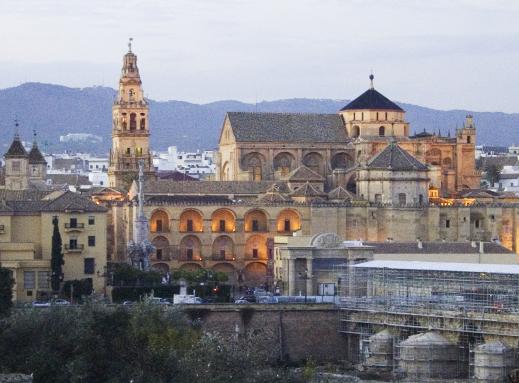





|
Today, Wednesday, turned out to be our last day of picture-taking, since the weather in Toledo would be so dark, gray, and rainy, but for me it was in many ways the pinnacle of our stay in Spain.
We got up around eight this morning and had a nice big breakfast in the hotel. Oh, that Spanish ham! Then, after the usual preparations, we went out in the expectation of doing our tourist thing in the Grand Mosque, getting there at 10:40. At the entrance though, we saw a sign saying that it would not be open for tourism till 14:00. Duh! Today was a Holy Day of Obligation, All Saints’s day. And since this great tourist attraction, the Mosque, and the Cathedral are in some sense one, the ecclesiastical uses naturally had to take precedence over the touristic ones.
Instead, we went looking for the Museo Arqueológico. This should have been a great hour’s entertainment, but after we finally found it, we discovered that it, too, was shut. Tight as a drum! Holy Day, after all, undoubtedly a state holiday. And we wouldn’t have any time Thursday to stop by for a visit. So that was that.
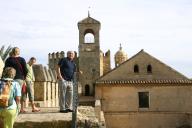
|
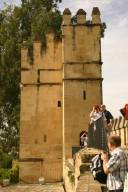
|
Instead we made our way to one of the other big tourist attractions of Córdoba, the Alcázares Reales, royal palace(s). This is a huge old pile, successively used by the Arabs, the Christian kings before 1492, and by various officialdoms after the Reconquest. Most notable among these officialdoms was the Inquisition, which used it for many years. This information really struck my imagination in the very worst way, and I could not look at the gloomy interior rooms without calling up images of Jonathan Lubin imprisoned for heresy or “Judaizing”, that wonderful, colorful, word that the Spaniards applied to any Converso accused of backsliding into the ancestral religion. Since everybody in Spain presumably had some Jewish ancestry, just as they all had some Moorish, this was a grave accusation that could be turned against anyone at all by an enemy desirous of an opponent’s ruination.
So, in every room we visited in the Alcázares, my imagination ran wild. Was this a judgment room, where a panel of priests, hooded like Klansmen, passed their doom on some hapless citizen caught up in the toils of hatred? Was this tiny alcove a confinement room, even though there was no trace of a door frame to it now? What about this horizontal slit in the wall? I imagined that someone was bricked up in there once, with only the slit communicating to the outside, for food to be passed through. And the skeleton still inside now, in my imagination at least, clothed in mouldering and filthy rags. (Perhaps you can see that my idea of pre-1830’s Spain is totally the result of my having seen too many Goya prints and paintings!)
I can claim all that as an excuse for taking no pictures inside the Alcázares, but the real reason is that I didn’t have my monopod with me, and it was far too murky in those chambers to get any kind of adequate pictures by available light. The two I have, above, were taken on the parapet in full sunlight, and filled with happy tourists, obviously enencumbered by an overactive imagination. (Left image: small, large; right image: small, large.)
After the Alcázares, we walked back to the Museo Arqueológico, in the hopes that it might open after noon. In the square nearby was a perfectly acceptable outdoor café, where I had a beer, and Mark a Coca-Cola, since he was still being cautious after his bad experience in Ronda. We shared a half-portion of ham, and another of potato salad for a nice light lunch, which we finished off with coffee and another Coke, plus a flan with two spoons. By two in the afternoon, the museum still hadn’t opened, so at 1401 we started off for the Mosque. There were already a lot of people waiting to get entrance tickets when we got inside the walls that encircle the Cathedral grounds; there was broad sunlight this day, as you see in the pictures above, and as soon as we went inside the Mosque, we were plunged into a dimness that is not conveyed by any of the pictures below, except for the one in the fourth row, below.
| ||||||||||||
| ||||||||||||
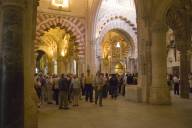
| ||||||||||||
| Small image; large |
The Mosque is broad—extremely extensive in area, in fact—rather than high, and the only lighting is from the windows and from the very tasteful lamps that you see in many of the pictures: at the center of the top of the top left one, for instance. Even if the Spaniards may not be in sympathy with Islam, they have done a wonderful job of presenting the mosque part of the Mosque in a sympathetic way. The pictures, all but the right one in the fourth row, are completely misleading, since I just told my camera to adjust for the dimness, and get as good exposure as it knew how to. In that one darker picture, I intentionally reset the exposure to give a more realistic impression of the dark atmosphere. The word I kept thinking of when I was standing there was “tenebrous”—dusklike in dimness—for the essence of the place, for me anyway, was the dimness, which led to a very religious feeling, whatever that may mean.
I don’t know how to explain or describe the feeling that the Mosque gave me. Maybe it was fact that the beauty of the place was so unexpected, at least by me. I knew, from all the reports, and from the many mathematical references to the Alhambra in Granada, that that would be beautiful and impressive; but nobody told me about the Mosque of Córdoba. I understood, at least vaguely, that Córdoba was the capital of the Arabic kingdom of Al Andalus, and I remembered the sheik’s words in “Lawrence of Arabia” about the beauty of the city, and the fact that it had street lighting at a time when no city of Christian Europe would have thought of such a thing. And I’ve seen the City Hall of Cambridge, and knew that its Boston architect was making a Moorish reference. But I just had no idea of the overwhelmingness of the original.
At first glance, you may find a sameness to my pictures of the Mosque, but some of them at least were taken to show what I thought were notable features of the place. In the left picture, third row, for example, you can get an idea of the immense size of the Mosque: look at the little lit arch way in the distance, directly in the center of the shot. Or in the next one over, the contrast between the dimness of the Mosque (brightened up by my camera, as I’ve explained previously) and the high lighting of the Cathedral section of the structure in the distance, which I’ll talk about at much greater length in the next paragraphs. In the bottom picture of this group, taken in the Christian part of the building (you can see a crucifix at the extreme right), again the lighting from the church’s windows is shown rather well, in contrast to the mosquey darkness illuminated by electricity, farther to the left.
What happened in the Mosque is that after the Christians came back into power in Córdoba, they needed a cathedral. The usual practice during those Reconquest days was to take over the site of a mosque and make the church there, often on the very foundations of the preexisting Muslim holy place. This, after all, had been the practice for centuries, whenever Christianity took the place of paganism. But here, the Mosque was far too big for its walls to be the walls of a cathedral. So they simply knocked a hole in the roof, at the center of the Grand Mosque, and built their cathedral up from there. The effect is that you go from the murky and restrained Mosque directly into the Gothic-bright and Baroque-excessive Cathedral. It’s not the repose of the somewhat older French Gothic that you may be familiar with, like Chartres, but the frenetic overdecoration typical of the Spanish churches. I really was offended at what I considered, that day, to be a horrible desecration of the Mosque’s quiet beauty. It would have been perfectly possible, I reasoned, to build a Cathedral somewhere else in Córdoba.
I haven’t changed my mind much about this in the succeeding months, but Mark has made me see the reasonableness of another view. First, as the Church’s literature makes clear, the Mosque would not have been preserved if the Cathedral had not been part of the structure. Indeed, the Alhambra was falling into serious disrepair till the early nineteenth century, when Washington Irving’s Tales of the Alhambra brought the monument to the world’s attention. Second, what we could see here was something completely unique in the world: the melding of a full-fledged Christian cathedral with a recognizable Muslim mosque.
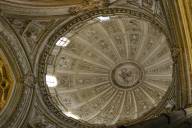
|
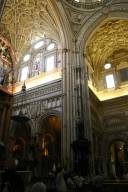
|
Because of my horror at what had been done to the Mosque, I took relatively few pictures in the Cathedral section of the building; two are at the right. In the lefthand one, you see that here too, as in Sevilla, the architects had shown their skill off by making an elliptical dome (small image; large), and in the righthand one (small image; large), you can witness the exuberant overdecoration that the Cathedral is filled with.
Well, after an hour or more of dazzlement, we stumbled out of the Mosque, gasping from the beauty, spent a little time in the gardens outside the structure but still inside the walls of the Mosque-Cathedral precinct, and walked about in the city a little more. This was pretty much the end of our picture taking. We walked back over the river to the hotel, had a nap, and then at Spanish supper-time, we crossed the river once more to a restaurant just at the end of the bridge, where we had an adequate but undistinguished meal before going back to the hotel for our last night in Córdoba.
Go to the next day’s page; to the previous day’s page.
Return to the Spain index page; to my main page.